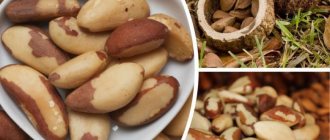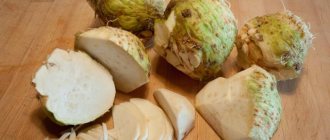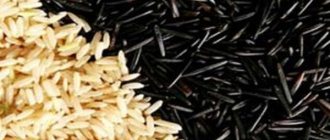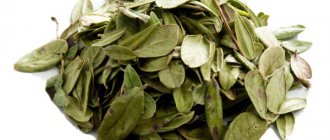What are the benefits of Turnip?
- Vitamin C
is involved in redox reactions, the functioning of the immune system, and promotes the absorption of iron. Deficiency leads to loose and bleeding gums, nosebleeds due to increased permeability and fragility of blood capillaries. - Silicon
is included as a structural component in glycosaminoglycans and stimulates collagen synthesis. - Cobalt
is part of vitamin B12. Activates enzymes of fatty acid metabolism and folic acid metabolism.
You can see a complete guide to the healthiest foods in the “My Healthy Diet” app.
- home
- Product composition
- Composition vegetables and herbs
- Chemical composition of "Turnip"
Tags:
Turnip calorie content 32 kcal, chemical composition, nutritional value, vitamins, minerals, what is useful Turnip, calories, nutrients, beneficial properties Turnip
Energy value, or calorie content
- this is the amount of energy released in the human body from food during the digestion process. The energy value of the product is measured in kilocalories (kcal) or kilojoules (kJ) per 100 grams. product. The kilocalorie used to measure the energy value of food is also called a food calorie, so when caloric content is reported in (kilo)calories, the prefix kilo is often omitted. You can see detailed energy value tables for Russian products here.
The nutritional value
— content of carbohydrates, fats and proteins in the product.
Nutritional value of food product
- a set of properties of a food product, in the presence of which the physiological needs of a person for the necessary substances and energy are satisfied.
Vitamins
, organic substances required in small quantities in the diet of both humans and most vertebrates. Vitamin synthesis is usually carried out by plants, not animals. A person's daily requirement for vitamins is only a few milligrams or micrograms. Unlike inorganic substances, vitamins are destroyed by strong heat. Many vitamins are unstable and are “lost” during cooking or food processing.
calorie content, benefits and harm to the health of the body, use for weight loss
Turnip is a dietary vegetable that is rich in nutrients. The plant contains a huge amount of microelements and vitamins that improve the functioning of all organs and systems of the human body. The main wealth of the vegetable is ascorbic acid. In terms of vitamin C content, turnips are superior to oranges and other citrus fruits. The root vegetable contains a lot of indigestible fibers, which prevent toxins from being absorbed in the intestines.
1
Benefit for health
Turnips contain microelements, biologically active substances, and vitamins. In terms of the content of coarse dietary fiber, the vegetable is ahead of other members of the cabbage family, including horseradish. Fiber is not digested in the small intestine, but swells with water, and as it moves through the colon, it removes up to 10% of the cholesterol from fatty foods and cancer-causing toxins.
Useful compounds and vitamins in turnips:
- Ascorbic acid is responsible for the elasticity of all organs, including skin and blood vessels.
- Folic acid is necessary for human hematopoiesis.
- Isocyanates - substances that have an anti-cancer effect, are contained in the tops.
Benefits of the plant:
- enhances intestinal function;
- speeds up digestion;
- promotes the production of gastric juice;
- cleanses the body of toxins;
- increases immunity;
- relieves vitamin deficiency;
- prevents colds;
- stimulates the gallbladder;
- prevents the formation of stones;
- strengthens teeth and nails;
- improves skin condition.
The usefulness of black, yellow, green and white turnips is the same. The color of the peel depends on the variety, but the chemical composition of the vegetables remains unchanged.
Mayonnaise: benefits and harm to the health of the body
1.1
For women
The plant is especially useful for women in menopause, it calms the nerves and evens out the emotional background. The vegetable can be eaten to improve the condition of nails, hair and skin (turnip helps fight rashes on the face).
The root vegetable is a champion in organic sulfur content. This healing element is necessary to maintain youth and good skin condition, it cleanses the blood, strengthens the immune system, increases bile production, and protects against toxins and radioactive contamination.
Calorie content of tangerine: benefits and harm to health
1.1.1
During pregnancy
Dishes made from boiled and stewed turnip vegetables are tasty, nutritious, easily digestible, and supply the pregnant woman’s body with essential microelements and vitamins. The root vegetable and its juice can be used as a folk remedy to treat colds, since many medications are prohibited for women during pregnancy.
Expectant mothers can include the product in salads and soups, combining it with other vegetables, meat and fish. To get rid of the bitter taste of raw turnips, just pour boiling water over the root vegetable.
Quinoa: benefits, harm and recipes for weight loss
1.2
For men
Vitamin B in the plant normalizes the hormonal levels of men, which helps increase libido and improve erection.
All cruciferous vegetables, and especially turnips, contain plant antibiotics and phytoncides. Given the mild diuretic effect of the vegetable, antibiotics quickly remove pathogenic microflora from the urethra.
1.3
For children
Vegetable puree from root vegetables can be introduced into a child’s diet from 6 months. The minerals and vitamins that make up turnips are necessary for the full growth and development of the baby. Carbohydrates in vegetables normalize the functioning of the digestive system and can be combined with any food. The product helps the absorption of iron and, thus, promotes faster development of the child's brain.
1.4
For diabetes
The healing properties of turnips are invaluable for people with diabetes due to the folic acid content in it. Other vitamins contained in the vegetable are also useful for this disease:
The product, even after heat treatment, is eaten without salt, which is especially important for diabetics. Turnip helps lower blood sugar and improves kidney function. For type 2 diabetes, baked vegetables are most beneficial.
2
Contraindications
Due to the high content of essential oils, there are a number of contraindications for consuming turnips.
Eating a large amount of vegetables out of habit can cause gas formation in the intestines.
People with the following health problems should not abuse the product:
- inflammation of the gastrointestinal tract;
- stomach and duodenal ulcers;
- gastritis of any type;
- malfunction of the thyroid gland;
- chronic liver and kidney diseases.
Patients with pancreatic diseases, including diabetics, can eat turnips only after the permission of the attending physician.
When consuming root vegetables, like any other medicinal product, you should observe moderation. It is enough to eat no more than 300 g per day. In order not to harm the body, improve the digestibility of the vegetable and prevent the formation of gases in the intestines, it is better to eat the product heat-treated - boiled or steamed.
3
Calorie content and BZHU
Turnips are low in calories. It can be safely used by people suffering from excess weight or those who care about the beauty of their figure. BJU of the product: 19%/3%/78%.
Calorie content per 100 grams:
- raw turnip contains 31.5 kcal;
- boiled - 33 kcal;
- steamed - 30 kcal.
Nutritional value per 100 grams:
- proteins - 1.5 g;
- fats - 0.1 g;
- carbohydrates - 6.2 g.
Turnip composition:
| Magnitude | Quantity per 100 grams |
| Calorie content | 32 kcal |
| Fat | 0.1 g |
| Protein | 1.5 g |
| Carbohydrates | 6.2 g |
| Water | 90 g |
| Coarse fibers | 2.0 g |
| Organic acids | 0.1 g |
| Sahara | 6.0 g |
| Minerals | K (238 mg), Ca (49 mg) |
The vegetable also contains vitamins A, B1, B2, C, E, PP, Beta-carotene.
4
How to use turnips for weight loss?
Turnip is an ideal dietary product; you can use it to prepare breakfasts, lunches, dinners and snacks with a minimum amount of calories. Non-digestible fiber, which the vegetable is rich in, cleanses the intestines, promoting weight loss. The main way to consume the root vegetable for those who want to lose weight is in its raw form. This product completely preserves all vitamins, including vitamin C, which is destroyed during heat treatment.
If you boil turnips in a double boiler and crush them, you get a dietary substitute for mashed potatoes - low in calories, with a spicy bitterness, and a pleasant creamy color.
The turnip diet involves eating vegetables 2 times a day and taking 1.3 liters of decoction daily. Turnips are included in the dietary menu in any form - boiled, stewed, baked.
Decoction recipe:
- 1. Pour 3 root vegetables along with tops with 1.5 liters of cold water.
- 2. Cook without salt, boil for 5 minutes.
- 3. Wait until it cools down naturally.
The decoction is drunk instead of water at any time of the day. During the diet, you can eat everything except fatty, sweet and salty foods. The starchy vegetable eliminates the feeling of hunger, so the diet is comfortable.
Sample menu for a turnip diet for weight loss:
- 1. Breakfast - raw vegetable salad, boiled egg.
- 2. Snack – fruit.
- 3. Lunch – boiled chicken, garnished with turnip puree and rye bread.
- 4. Afternoon snack – coffee with chocolate or cheese.
- 5. Dinner – fish and grated carrots with turnips or turnips on the side.
To look good without a diet, you can also arrange one fasting day a week, during which you eat 1 kg of root vegetables without salt. The vegetable can be eaten raw and any dishes can be prepared from it. To lose weight without a diet, it is also recommended to simply include turnips in your diet 2-3 times a week, this will ensure slow weight loss.
tonustela.net
Calorie content of turnips
Turnip can easily be called the most ancient vegetable crop: its history goes back about four thousand years. This vegetable was cultivated in Ancient Rome, Egypt, and Greece. Attitudes towards it were different - the Greeks and Egyptians considered it the food of the poor, and the Romans used the vegetable for festive meals. Before the appearance of potatoes in Rus', the main garden crops were turnips and rutabaga. These vegetables are perfectly stored until spring, almost without losing their nutritional qualities.
Turnip is a representative of the cruciferous plant family, belongs to the cabbage genus, the Latin name is Brassica rapa. It bears fruit in the first year, but if the root crop is left in the soil, in the second year it will shoot a flower and produce seeds. The round-shaped vegetable comes in different sizes and, depending on the variety, can weigh from 100 to 500 g.
Turnip is a very useful product. It combines high nutritional qualities with numerous medicinal properties. It saturates perfectly, but does not create fat reserves in the body, as it has low calorie content. The presence in this vegetable of a universal complex of vitamins, mineral salts, essential oils, organic acids, and plant fiber has a positive effect on all body systems.
They eat turnips raw, boiled, stewed, baked, fried, use them as a seasoning for soups and main courses, add them to sauces, and prepare vegetable cocktails and smoothies from them. The tender, juicy pulp of the root vegetable is quickly digested, which makes it possible to use it for dietary and baby food.
This vegetable crop has a lot of healing qualities:
- stimulates the production of gastric secretions;
- improves intestinal motility;
- has anti-inflammatory, diuretic, expectorant effects;
- promotes the dissolution of kidney stones and salt deposits in the joints;
- normalizes blood sugar levels;
- improves metabolism;
- reduces the level of “bad” cholesterol;
- removes excess fluid;
- helps cleanse the intestines of toxins;
- has a mild sedative effect, improves sleep;
- suppresses the development of pathological microflora in the intestines;
- has a positive effect on the cardiovascular and genitourinary systems, improves brain function;
- maintains visual acuity;
- increases immunity;
- improves the condition of skin, hair, teeth, prevents baldness;
- The decoction relieves toothache, relieves inflammation of the mucous membrane with tonsillitis, laryngitis, nasopharyngitis.
Recipe examples
Recipes for preparing turnips are varied. These include salads, soups, side dishes, and appetizers. Here are just some successful ways to include this vegetable in your diet.
Soups
Sour cabbage soup with meat. Classic sour cabbage soup with beef broth. Turnips do not replace any of the traditional ingredients of this dish, but only complement them. Mushroom soup. To prepare this soup, you can use any mushrooms, for example, healthy chanterelles, cherries or boletus.
Side dishes
Turnips go well with any meat dishes, chicken, turkey, mushrooms, etc. These side dishes can be prepared in different ways. You can use a turnip:
- put out;
- fry;
- or according to the ancient Russian recipe, make it steamed.
Salads
Turnips are, of course, eaten raw. That’s why they prepare a variety of light salads from it, for example, this salad with carrots and celery.
You can create more original snacks. At least in this salad with eggs and cheese.
However, not all salads include only raw vegetables. The beetroot salad recipe recommends not only sautéing the turnips, but even lightly frying them.
Blanks
Turnips can be pickled. Sometimes it is pickled alone, but more often in collaboration with other vegetables.
With beets. A simple traditional canning recipe with the addition of beets and spices - coriander seeds, fennel and garlic.
This is how you can prepare a vegetable salad for the winter.
There are also recipes for turnip dishes that are not only beneficial, but also fraught with harm. Basically, these are those dishes in which vegetables are combined with excess sugar. That is, all kinds of preserves, jams, candied fruits.
Can it be frozen?
Yes, they freeze turnips. Usually blanched.
- To freeze a vegetable, it must be peeled and cut into cubes.
- Then put the cubes in boiling water for 2-3 minutes.
- Remove with a slotted spoon and transfer to cold water.
- Place the cooled cubes on baking paper and let dry. Then spread on a tray in one layer, close with a bag or lid and put in the freezer for 2-3 hours.
- Pack frozen turnip pieces tightly into bags or containers. And put it back in the freezer.
Contraindications for eating turnips
Due to the high concentration of nutrients, medicinal properties and low calorie content, turnips are very often used as part of the diet or in various folk recipes. However, just because of its rich composition, turnips should be introduced with caution into the diet of women during lactation and children under two years of age, as intestinal problems (colic, diarrhea, constipation) or allergies may appear.
You should also know that turnips and their juice should not be consumed if you are diagnosed with an acute or chronic form of any of the following diseases:
- stomach and duodenal ulcers;
- gastritis with high acidity;
- erosive gastritis;
- cholecystitis;
- pancreatitis;
- colitis;
- cholelithiasis;
- hepatitis;
- diabetes;
- food allergies;
- disorders of the central nervous system.
Interesting facts about turnips
Turnip as a crop appeared in Western Asia and has been cultivated by humans for 4 thousand years.
A feed variety of turnip grown specifically for farm animals is called turnip.
In Ukraine, in ancient times, “spitters” of turnip seeds were held in special esteem. The seeds of this root vegetable were spat out during sowing due to their small size: one kilogram contains approximately a million seeds. In Rus', turnip seeds were not spat out, but only women could sow the field with them. It was believed that the harvest would be higher if women shared their reproductive power with the earth.
Until the nineteenth century, in Ireland and Britain, Halloween lanterns were carved from turnips or beets.
The Slavs had a special ritual to protect the home from evil spirits. On the eve of All Saints' Day, they cut out the middle of a large turnip, placed a burning candle inside and walked around the whole house with it, after which they placed it on the window to burn out.
In Rus', fields sown with turnips were called turnips, and the first day of harvest was called reporez.
In different countries there are celebrations associated with turnips. In Western Ukraine, the Hutsul Turnip culinary festival is held, although potatoes are called turnips there, and in the Swiss city of Richterswil, an annual festival of lamps carved from a real root vegetable takes place.
In battles between amusing regiments under young Peter I, the cannons became infected with steamed turnips.
In England, juice from turnip tops, carrots and dandelions was widely used to strengthen teeth.
During World War I in Germany, turnips were used instead of scarce meat and potatoes, and flour from them was used to make bread.
According to the old twelve-year garden calendar of some Slavic tribes, 2020 will be the year of turnips.
Mentions of turnips are an integral part of Russian folklore, which is reflected in numerous signs, riddles, proverbs and sayings.
Uses of turnips in Ayurveda and traditional Chinese medicine
The healing properties of turnips have been used for thousands of years in Ayurveda and Traditional Chinese Medicine.
Turnips fit into the Ayurvedic diet, which emphasizes the consumption of plenty of fruits and vegetables, as well as seasonal eating. Turnip in Ayurveda is a nutritious winter vegetable that can aid in cleansing and can be especially beneficial for those with kapha dosha.
In Traditional Chinese Medicine, on the other hand, turnips are well known for their ability to promote proper digestion. They are most often used to facilitate blood clotting, stimulate bowel movements, and remove phlegm from the body.
Nutritional value of turnip and its nutritional properties
Turnips are a nutrient-dense food, which means they are low in calories but high in dietary fiber and micronutrients such as vitamin C and potassium.
One cup of cooked turnips (about 150 grams) contains approximately:
Calories : 34.3 kcal Carbohydrates : 7.9 g. Proteins : 1.1 g. Fats : 0.1 gr. Fiber : 3.1 g. Vitamin C : 18.1 mg (30%) Potassium : 276 mg (8%) Manganese : 0.1 mg (6%) Vitamin B6 : 0.1 mg (5%) Calcium : 51.5 mg (5%) Folic acid : 14 mcg (4%) Magnesium : 14 mg (4%) Phosphorus : 40.6 mg (4%) Iron : 0.3 mg (2%) Riboflavin : 0.5 mg (2%) Pantothenic acid : 0.2 mg (2%)
In addition to the nutrients listed above, turnips also contain small amounts of other micronutrients, including thiamine and zinc.










